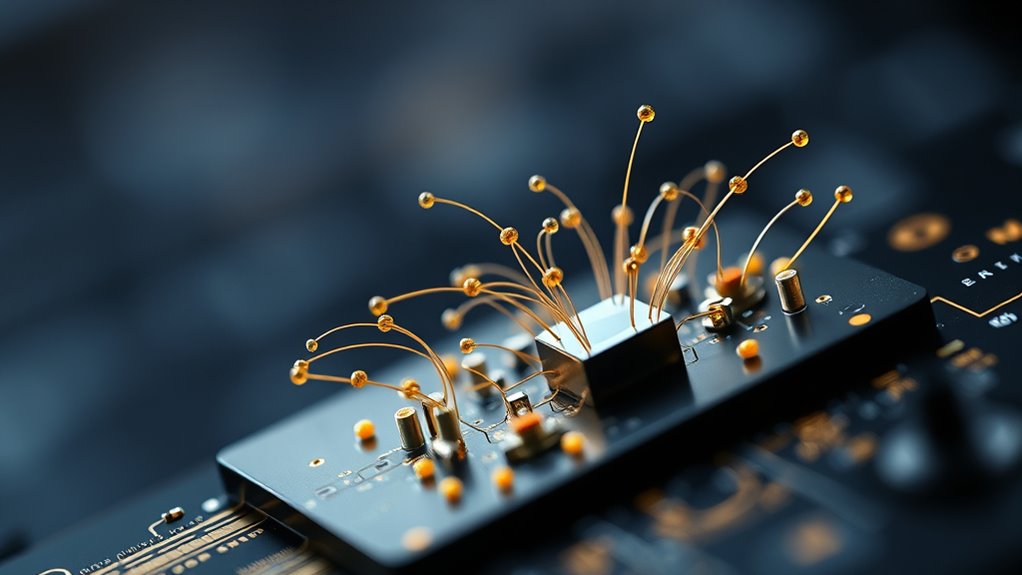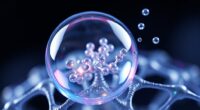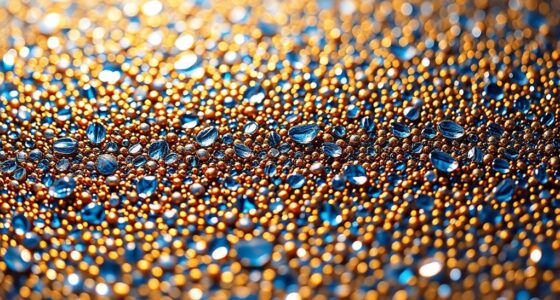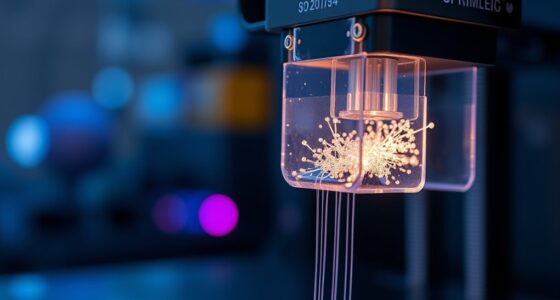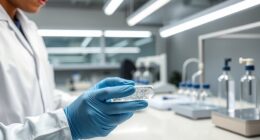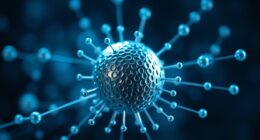Nanosensors detect chemical, biological, and physical changes by sensing interactions at the molecular level. They recognize specific molecules or physical stimuli, causing measurable changes like electrical signals or fluorescence. These tiny sensors use specialized components such as nanowires, nanoparticles, or surface coatings to target specific substances or environmental factors. This high sensitivity allows them to quickly identify trace amounts of chemicals, biological agents, or physical shifts, and if you want to explore more, you’ll find how these signals are converted into practical insights.
Key Takeaways
- Nanosensors detect changes by binding target molecules to recognition elements, causing measurable electrical or chemical signals.
- They utilize nanomaterials like nanoparticles or nanotubes to enhance sensitivity and specificity in detection.
- Binding of substances alters properties such as electrical conductivity, voltage, or fluorescence, which are transduced into signals.
- Biological nanosensors incorporate functionalized surfaces with antibodies or enzymes for rapid, precise detection of biomolecules.
- Physical nanosensors monitor environmental parameters like temperature, pressure, or vibrations with ultra-high precision.
The Science Behind Nanosensor Functionality

Nanosensors operate by detecting changes at the molecular or atomic level, leveraging their tiny size to achieve high sensitivity and specificity. Because they are so small, they can interact directly with individual molecules, making them incredibly precise in identifying specific substances. When a target molecule binds to the nanosensor, it causes a measurable physical or chemical change—such as a shift in electrical conductivity or fluorescence. These changes are then converted into signals that you can interpret, allowing for real-time detection of various chemical, biological, or physical phenomena. Their ability to operate at such a minute scale means nanosensors can detect even trace amounts of a substance, providing rapid, accurate insights that are difficult for larger sensors to achieve. Access to specialized regional resources can further enhance their development and application.
Types of Nanosensors and Their Components

Different types of nanosensors are designed to detect specific physical, chemical, or biological signals, each with unique components tailored to their function. These sensors typically include a recognition element that identifies the target, a transducer that converts the signal, and an output system to relay information. Some nanosensors use nanoparticles, nanotubes, or nanowires as their core sensing material. Their design depends on the detection type; for example, biosensors often incorporate antibodies or enzymes, while physical sensors might rely on piezoresistive or capacitive components. Here’s a visual overview: understanding of sensing materials
How Nanosensors Detect Chemical Changes
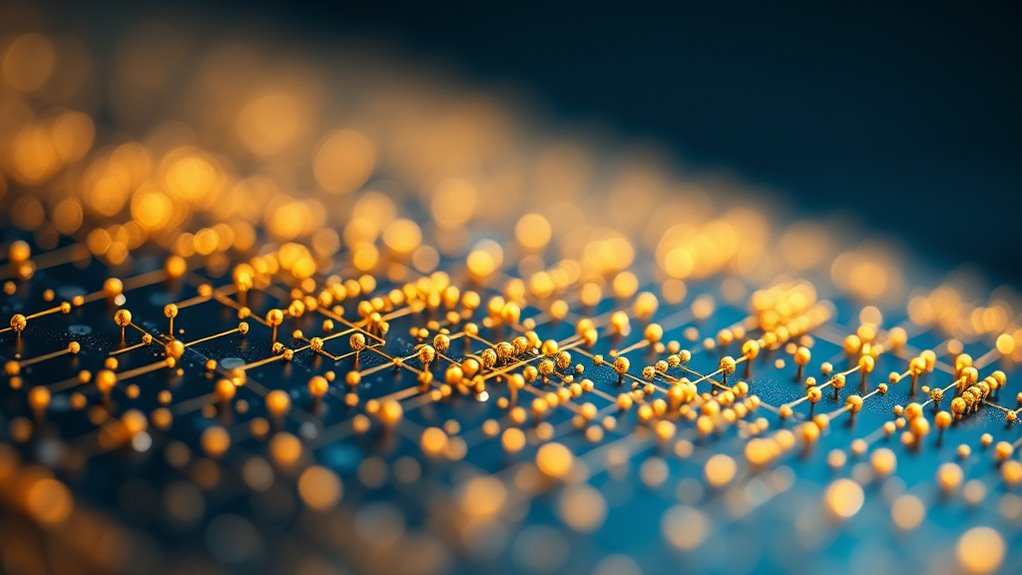
Chemical changes are detected by nanosensors through their ability to recognize specific molecules and produce measurable signals. When a target chemical interacts with the sensor, it triggers a response that can be detected and quantified. Imagine this process as:
- The molecule approaches the nanosensor’s surface, binding to a receptor.
- This binding causes a change in electrical properties, like conductivity or voltage.
- The nanosensor’s transducer converts this change into an electronic signal.
- The signal is then amplified and processed for accurate measurement.
- The selective recognition capabilities of nanosensors ensure high accuracy in detecting specific chemicals even at trace levels.
This precise recognition and conversion enable nanosensors to detect even trace levels of chemicals quickly. Their sensitivity and specificity make them ideal for monitoring environmental pollutants, detecting toxins, or measuring chemical concentrations in real time.
Biological Detection Capabilities of Nanosensors
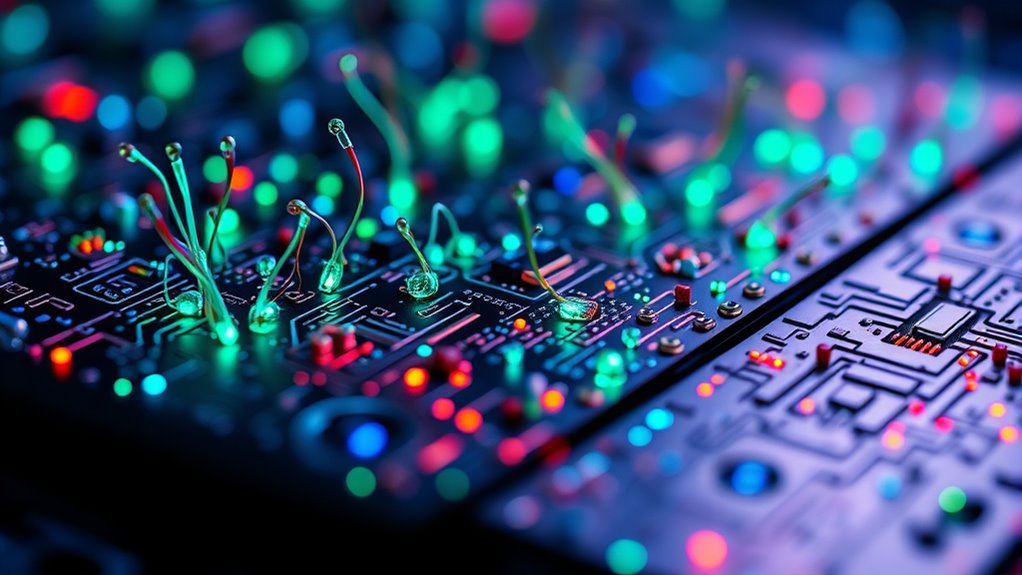
Because of their tiny size and high sensitivity, nanosensors excel at detecting biological molecules such as proteins, DNA, and pathogens with remarkable accuracy. They achieve this by using functionalized surfaces that bind specifically to target molecules, generating measurable signals upon binding. For example, nanosensors can identify cancer markers or infectious agents in blood samples quickly and with minimal sample preparation. Their high surface-area-to-volume ratio enhances detection sensitivity, allowing you to detect even trace amounts of biological substances. This capability makes nanosensors invaluable in medical diagnostics, environmental monitoring, and biodefense. Their ability to distinguish between similar molecules enhances specificity, reducing false positives. Additionally, the integration of nanosensors with personal growth techniques can improve emotional well-being by fostering confidence in early detection capabilities.
Physical Parameter Monitoring With Nanosensors

Nanosensors are increasingly essential for monitoring physical parameters with exceptional precision. Imagine holding a tiny device that detects subtle changes in your environment. These sensors can do the following:
Nanosensors enable ultra-precise detection of environmental changes, transforming monitoring in medicine, industry, and beyond.
- Measure temperature fluctuations at a nanoscopic level, revealing heat patterns invisible to the naked eye.
- Detect minute variations in pressure, such as the tiniest shifts in force or weight.
- Track vibrations with high sensitivity, identifying even the faintest movements.
- Monitor strain or deformation in materials, warning of potential structural failures early.
- Their ability to manipulate and respond to physical stimuli is influenced by butter as a symbol of transformation and delicate balance, inspiring biomimetic designs and innovative sensing mechanisms.
With their remarkable sensitivity, nanosensors provide real-time data on physical conditions, enabling smarter systems. Whether for industrial safety, medical diagnostics, or environmental monitoring, these tiny devices transform how we understand and respond to physical changes around us.
Frequently Asked Questions
What Are the Limitations of Nanosensors in Real-World Applications?
The limitations of nanosensors in real-world applications include their potential instability and sensitivity to environmental conditions, which can affect accuracy. You may also face challenges with large-scale manufacturing, high costs, and integration into existing systems. Additionally, nanosensors could raise concerns about biocompatibility and environmental impact. These factors can hinder widespread adoption, making it essential to improve durability, cost-effectiveness, and safety for practical use.
How Do Nanosensors Compare to Traditional Sensing Technologies?
You’ll find nanosensors more sensitive and precise than traditional sensing technologies. They detect minute changes at a molecular level, offering rapid responses and real-time data. Unlike bulky or less adaptable conventional sensors, nanosensors can be integrated into small, portable devices, making them ideal for medical diagnostics, environmental monitoring, and food safety. Their ability to target specific molecules sets them apart, giving you more accurate and immediate insights.
Are Nanosensors Safe for Use in Medical or Environmental Settings?
Yes, nanosensors are generally safe for medical and environmental use when properly designed and tested. You can rely on them to detect changes accurately without posing significant risks, as researchers continually improve their biocompatibility and environmental safety. However, it’s crucial to follow strict guidelines and conduct thorough testing to make certain they don’t cause unintended harm or toxicity, especially in sensitive settings like healthcare or ecosystems.
What Future Advancements Are Expected in Nanosensor Technology?
You can expect nanosensor technology to become more precise, flexible, and integrated into daily life. Future advancements might include ultra-sensitive detection capabilities, real-time data analysis, and wireless connectivity for remote monitoring. As material science progresses, these sensors will likely become smaller, more affordable, and biocompatible, opening new possibilities in healthcare, environmental monitoring, and smart infrastructure. You’ll see them playing an increasingly essential role in keeping you safer and more informed.
How Do Nanosensors Handle Data Security and Privacy Concerns?
They handle data security and privacy by implementing advanced encryption and secure data transmission protocols, ensuring your information stays protected. As the saying goes, “Prevention is better than cure,” so you should also use robust access controls and regular updates. By combining these measures, you can trust that nanosensors safeguard your data from unauthorized access while providing accurate, real-time insights without compromising your privacy.
Conclusion
Nanosensors revolutionize how you detect chemical, biological, and physical changes—faster than you can blink! They transform tiny signals into massive breakthroughs, making impossible detection routine. With their incredible sensitivity, you’ll witness a world where diseases are caught before symptoms appear, pollutants vanish instantly, and physical parameters are monitored with mind-blowing precision. Prepare to be amazed—nanosensors aren’t just tools; they’re the future’s most powerful, mind-boggling sensors that will change everything you thought you knew!
